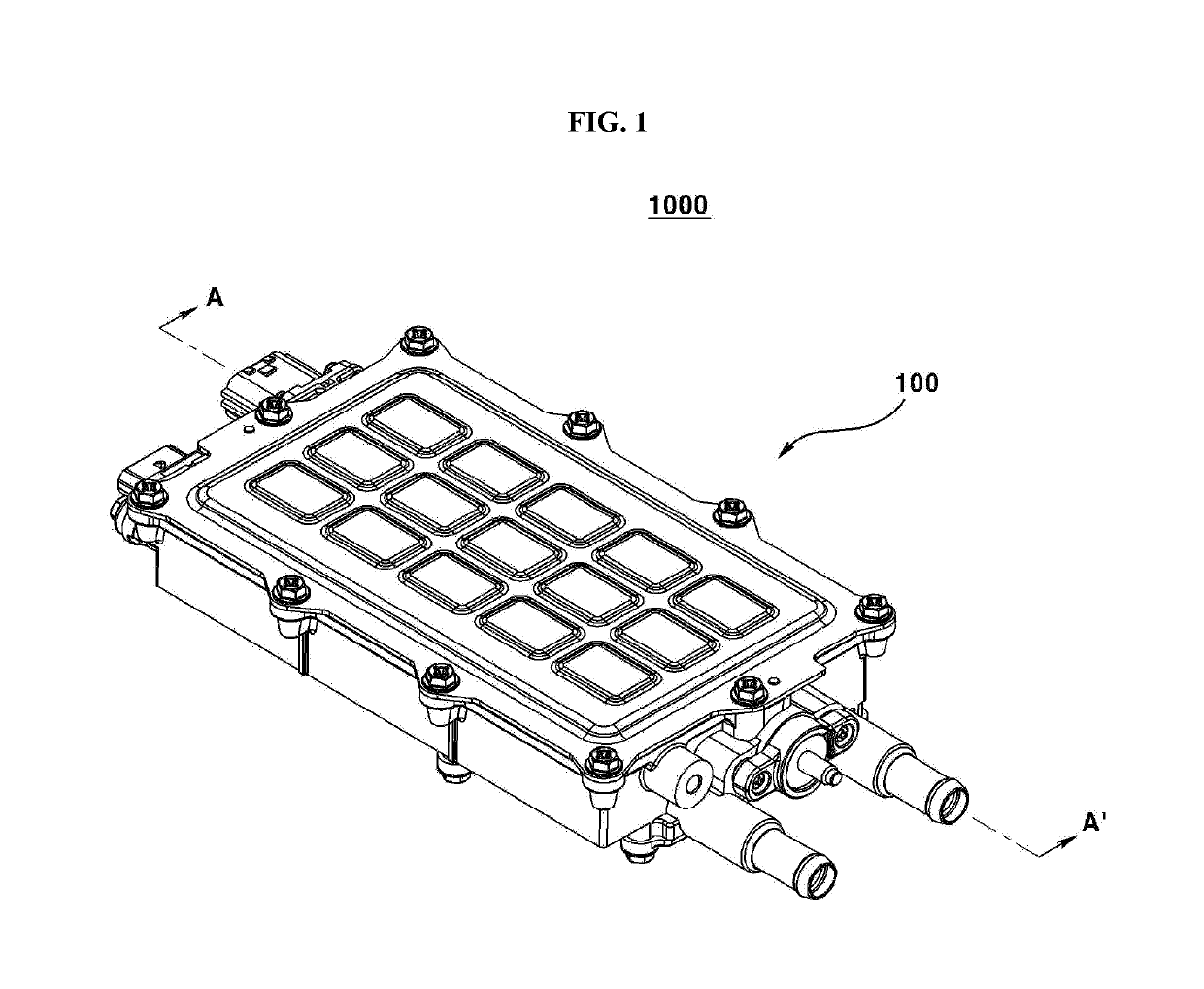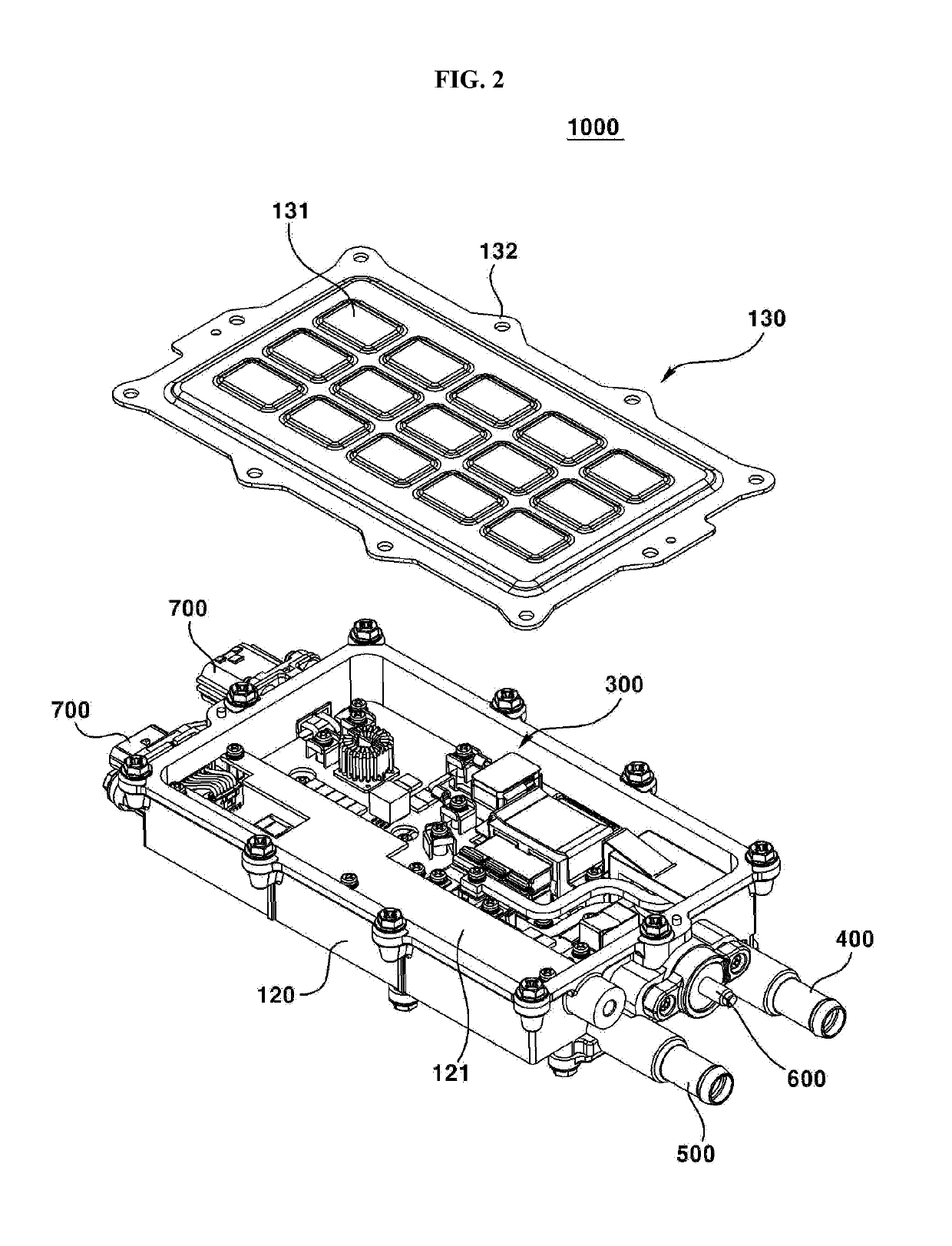Dc-dc converter
a converter and converter technology, applied in the direction of electrical apparatus casings/cabinets/drawers, process and machine control, instruments, etc., can solve the problems of inability to fully realize the coupling, and inability to achieve complete coupling, etc., to achieve the effect of reducing the pressure drop width, enhancing the cooling efficiency, and large heating valu
- Summary
- Abstract
- Description
- Claims
- Application Information
AI Technical Summary
Benefits of technology
Problems solved by technology
Method used
Image
Examples
first embodiment
[0078]Hereinafter, “vertical direction” may mean upward and / or downward direction, and “horizontal direction” may mean any one of directions on a plane perpendicular to “vertical direction.” The “vertical direction” may be the horizontal width direction of the flow path 200, and the “horizontal direction” may be the horizontal width direction of the flow path 200. The “vertical cross section” may mean a cross section perpendicular to the moving direction of the cooling material, and the “horizontal cross section” may be a cross section perpendicular to the “vertical cross section.”
[0079]Hereinafter, a DC-DC converter 1 of the first embodiment will be described with reference to the drawings. FIG. 1 is a perspective view of a DC-DC converter of the first embodiment viewed from above; FIG. 2 is a perspective view of the DC-DC converter of the first embodiment wherein the upper cover is disassembled; FIG. 3 is a perspective view of the DC-DC converter of the first embodiment wherein th...
second embodiment
[0134]Hereinafter, a DC-DC converter 2001 according to a comparative example of the present second embodiment will be described with reference to the drawings. FIG. 10 is a perspective view illustrating a DC-DC converter of a comparative example of the second embodiment.
[0135]The DC-DC converter 2001 of the present comparative embodiment may be a DC-DC converter used in a vehicle. For example, the DC-DC converter 1000 may play the role of receiving an electric current from an external power supply device (such as a lithium ion battery), boosting or lowering a voltage, supplying the voltage to an external electronic device (such as a motor), and thereby controlling the number of revolutions of a motor and the like. The DC-DC converter 2001 may comprise a case 2010, a conversion unit 2020, an inductor unit 2030, a bus bar (not shown), and an external terminal 2050.
[0136]The case 2010 may be an external member of the DC-DC converter 2001. In the case 2001, an internal space is formed t...
third embodiment
[0184]Hereinafter, the DC-DC converter 3001 of the third embodiment will be described with reference to the drawings. FIG. 16 is a perspective view illustrating the DC-DC converter of the third embodiment with the first cover removed; FIG. 17 is a cut-away perspective view illustrating the DC-DC converter of the third embodiment; FIG. 18 is a cross sectional conceptual view illustrating a main board, an auxiliary board and a cooling plate of the DC-DC converter of the third embodiment; and FIG. 19 is a conceptual diagram illustrating a signal leg of the DC-DC converter of the third embodiment.
[0185]A DC-DC converter 3001 of the third embodiment may be a DC-DC converter used in a vehicle. For example, the DC-DC converter 1000 may play the role of receiving an electric current from an external power supply device (such as a lithium ion battery), boosting or lowering a voltage, supplying the voltage to an external electronic device (such as a motor), and thereby controlling the number ...
PUM
 Login to View More
Login to View More Abstract
Description
Claims
Application Information
 Login to View More
Login to View More - R&D
- Intellectual Property
- Life Sciences
- Materials
- Tech Scout
- Unparalleled Data Quality
- Higher Quality Content
- 60% Fewer Hallucinations
Browse by: Latest US Patents, China's latest patents, Technical Efficacy Thesaurus, Application Domain, Technology Topic, Popular Technical Reports.
© 2025 PatSnap. All rights reserved.Legal|Privacy policy|Modern Slavery Act Transparency Statement|Sitemap|About US| Contact US: help@patsnap.com



